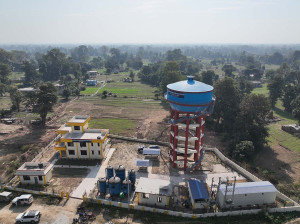Money
Imports from south fall while EVs boost imports from north
Shipments from China to Nepal increased by 34.8 percent, while those from India fell by 3 percent.
Krishana Prasain
Imports from China to Nepal rose more sharply than expected in the first eleven months of the current fiscal year ending mid-June, while imports from India continued to tumble.
According to the Trade and Export Promotion Center, the national trade promotion body, Nepal’s imports from China increased by 34.8 percent in the review period. In comparison, imports from India fell by 3.1 percent.
Experts attributed ballooning imports from China to a sharp rise in the entry of electric vehicles (EVs). Likewise, a fall in imports from India has been attributed to the export curbs on food by the southern neighbour.
In terms of value, imports from China increased by Rs70.44 billion to Rs272.81 billion in the review period.
Import from India, however, dropped by Rs29.53 billion to Rs908.30 billion in the period.
Due to the drop in imports from India, Nepal’s total imports declined 1.8 percent to Rs1.45 trillion in the first eleven months of the current fiscal year, which ended mid-June 2024.
An official of the National Statistics Office says for a consumption-driven economy, falling imports are a worrisome sign. This suggests people are spending less on services and consumption while exports are stagnant.
Rabindra Duwadi, the spokesperson at the Trade and Export Promotion Center, said imports from the north were driven by a massive influx of EVs, smartphones, and readymade garments.
Besides, exports of iron, chemical fertiliser, apples and readymade garments too rose significantly.
Traders said that China fulfils 80 percent of Nepal's readymade garment needs. The country imported readymade garments worth Rs33.67 billion in the first 11 months of the current fiscal year.
In the same vein, Nepal imported 7,931 EVs worth Rs21.83 billion from China in the first 11 months of the current fiscal year, up from 1,269 EVs worth Rs3.75 billion in the same period last fiscal year.
Similarly, the country imported 1.23 million units of smartphones worth Rs17.27 billion from China in the review period.
During the time, Nepal imported 99,965 tonnes of chemical fertiliser worth Rs8.69 billion from China.
In the first 11 months of the current fiscal year, the country imported 65,827 tonnes of apples worth Rs6.98 billion from China, compared to 50,153 tonnes worth Rs4.73 billion in the same period last fiscal year.
Duwadi said India’s share of Nepal’s total imports is 65.5 percent, while China contributes 18.8 percent.
Traders say Nepal’s trade with India is vast, but it is steadily shifting to China.
“One key reason for import growth from China is EVs,” said Rajan Sharma, a trade expert. “Chinese EVs are comparatively cheaper and perform better compared to Indian ones.”
According to market observers, that’s why there has been an abrupt switch from India’s Tata Nexon EV to Chinese BYD.
Sharma said readymade garments imported from China are cheaper compared to Indian readymade garments, including branded ones, which makes them popular among Nepali customers. “At the same time, India-made branded clothing items are expensive.”
The Chinese Shein clothing brand has quickly gained popularity in Nepal due to its trendy clothes and reasonable prices.
Trade experts say that due to the open border, there has been a massive rise in informal trade from India in recent years.
Smuggling has thrived after India imposed a ban on foods.
According to a research report titled, ‘Dynamics of informal cross-border trade in agricultural products between Nepal and India,’ prepared by South Asia Watch on Trade, Economics and Environment, only 40 percent of rice is imported from India through formal channels.
India’s share in Nepal’s imports in formal trade is 60 percent, but the share of informal trade is likely to be higher.
The research has pointed out that informal trade has thrived after the imposition of a 9 percent agriculture reform fee and a 2.5 percent advanced income tax, resulting in a total duty of 11.5 percent on rice imports.
The paper said that India’s ban on rice and other agricultural exports has led to massive smuggling of food through the 1,800 km porous border between Nepal and India.
Nepal is dependent on onions imported from India. When the Indian government imposed a ban on onion exports from December 2023 to May 2024, the product was readily available in the vegetable market and grocery stores, which indicated that a massive quantity of onions came through informal trade channels.
The government did not take a single step to control the illegal trade or negotiate with the Indian government to ease the repeated bans on export of various agricultural goods. Nepal has thus lost out on huge import revenue as goods are coming to Nepal through illegal channels and are easily available in the market.
Paras Kharel, executive director of the South Asia Watch on Trade, Economics and Environment, said overall imports have not been able to rebound in two fiscal years, reflecting the country’s economic slowdown. However, the rise in EV imports contributed to the sudden rise in imports from China.
“Imports from Tatopani and Rasuwa customs rose by twice as much,” Kharel said. This shows that imports from China, which were halted after the Covid pandemic, are not gradually improving but are ballooning.
According to the Department of Customs, the worth of imports from Tatopani customs increased to Rs37.16 billion in the first 11 months of the current fiscal year, compared to Rs11.79 billion in the same period last fiscal year.
Similarly, the worth of imports from Rasuwa customs on the northern border increased to Rs55.45 billion in the review period, up from Rs27.25 billion in the same period last fiscal year.




 8.12°C Kathmandu
8.12°C Kathmandu















